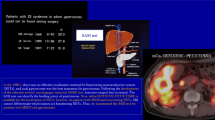Abstract
The number of duodenal neuroendocrine tumors has recently increased, but their natural history has not been well characterized. Here we report the case of a 59-year-old female undergoing complete resection by endoscopic mucosal resection after monitoring endoscopic morphologic changes and the size increment of a duodenal neuroendocrine tumor over the longest follow-up duration. An elevated lesion was initially detected on the duodenal bulb. Endoscopic biopsy from this lesion was performed three times during the follow-up, but all of the specimens simply demonstrated the presence of gastric metaplasia. Thereafter, in the esophagogastroduodenoscopy performed 14 years after the initial examination, a slight depression was detected in the center of the lesion together with an incremental change of its size. The histopathologic diagnosis of neuroendocrine tumor was made by deeper tissue sampling, and the patient subsequently underwent endoscopic mucosal resection for this tumor and was finally diagnosed with a G1 duodenal neuroendocrine tumor with pT2 cN0, cM0, stage IIa in the TNM classification. This is the first case demonstrating the slowly progressive nature of such a tumor with the longest follow-up of a duodenal neuroendocrine tumor ever reported, which could provide important information regarding the natural history and management of such tumors.



Similar content being viewed by others
Abbreviations
- D-NET:
-
Duodenal neuroendocrine tumor
- EMR:
-
Endoscopic mucosal resection
- EGD:
-
Esophagogastroduodenoscopy
- NET:
-
Neuroendocrine tumor
- EUS:
-
Endoscopic ultrasonography
- CT:
-
Computed tomography
- ENETS:
-
European Neuroendocrine Tumor Society
- WHO:
-
World Health Organization
References
Scherubl H, Jensen RT, Cadiot G, et al. Neuroendocrine tumors of the small bowels are on the rise: early aspects and management. World J Gastrointest Endosc. 2010;2:325–34.
Burke AP, Sobin LH, Federspiel BH, et al. Carcinoid tumors of the duodenum. A clinicopathologic study of 99 cases. Arch Pathol Lab Med. 1990;114:700–4.
Urso E, Pucciarelli S, Cassaro M, et al. Long-term follow-up after endoscopic forceps biopsies for early stage duodenal carcinoid: case report and review of endoscopic treatments. Endoscopy. 2007;39(Suppl 1):E128.
Yamamoto C, Aoyagi K, Suekane H, et al. Carcinoid tumors of the duodenum: report of three cases treated by endoscopic resection. Endoscopy. 1997;29:218–21.
Wengrower D, Fich A. Primary duodenal carcinoid. Am J Gastroenterol. 1987;82:1069–70.
Min BH, Kim ER, Lee JH, et al. Management strategy for small duodenal carcinoid tumors: does conservative management with close follow-up represent an alternative to endoscopic treatment? Digestion. 2013;87:247–53.
Sarbia M, Sauer G, Karimi D, et al. Foveolar gastric metaplasia of the duodenum: a frequent, so far neglected type of duodenal polyp. Z Gastroenterol. 2014;52:348–50.
Delle Fave G, O’Toole D, Sundin A, et al. ENETS consensus guidelines update for gastroduodenal neuroendocrine neoplasms. Neuroendocrinology. 2016;103:119–24.
Terada T. Heterotopic gastric mucosa of the gastrointestinal tract: a histopathologic study of 158 cases. Pathol Res Pract. 2011;207:148–50.
Langkemper R, Hoek AC, Dekker W, et al. Elevated lesions in the duodenal bulb caused by heterotopic gastric mucosa. Radiology. 1980;137:621–4.
Lessells AM, Martin DF. Heterotopic gastric mucosa in the duodenum. J Clin Pathol. 1982;35:591–5.
Uraoka M, Fuchigami T, Iida M, et al. Clinico-pathological investigation of heterotopic gastric mucosa of the duodenum. Gastroenterol Endosc. 1986;28:3078–85.
Eguchi K, Aoyagi K, Nimura S, et al. Diagnostic value of endoscopic and endoscopic ultrasound characteristics of duodenal submucosal tumour-like heterotopic gastric mucosa. Can J Gastroenterol. 2011;25:365–7.
Guideline for pancreatic and gastroenteric neuroendocrine tumor. In: Japan Neuroendocrine Tumor Society. ISBN: 978-4-307-20339-5, 2015 (in Japanese).
Margonis GA, Samaha M, Kim Y, et al. A multi-institutional analysis of duodenal neuroendocrine tumors: tumor biology rather than extent of resection dictates prognosis. J Gastrointest Surg. 2016;20:1098–105.
Gincul R, Ponchon T, Napoleon B, et al. Endoscopic treatment of sporadic small duodenal and ampullary neuroendocrine tumors. Endoscopy. 2016;48:979–86.
Tsushimi T, Mori H, Harada T, et al. Laparoscopic and endoscopic cooperative surgery for duodenal neuroendocrine tumor (NET) G1: report of a case. Int J Surg Case Rep. 2014;5:1021–4.
Author information
Authors and Affiliations
Corresponding author
Ethics declarations
Conflict of interest
Kiichi Takahashi, Waku Hatta, Tomoyuki Koike, Takeshi Kanno, Nobuyuki Ara, Kiyotaka Asanuma, Naoki Asano, Akira Imatani, Fumiyoshi Fujishima, Hironobu Sasano, and Tooru Shimosegawa declare that they have no conflict of interest.
Human Rights
All procedures followed have been performed in accordance with the ethical standards laid down in the 1964 Declaration of Helsinki and its later amendments.
Informed Consent
Informed consent was obtained from all patients for being included in the study.
Rights and permissions
About this article
Cite this article
Takahashi, K., Hatta, W., Koike, T. et al. The slow progressive nature of duodenal neuroendocrine tumor: a case report of long-term observation over 14 years. Clin J Gastroenterol 10, 469–473 (2017). https://doi.org/10.1007/s12328-017-0758-8
Received:
Accepted:
Published:
Issue Date:
DOI: https://doi.org/10.1007/s12328-017-0758-8




